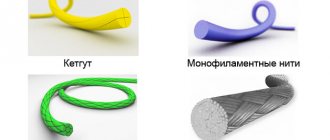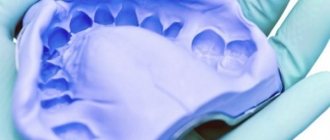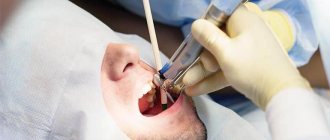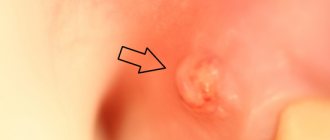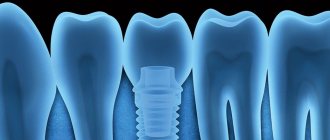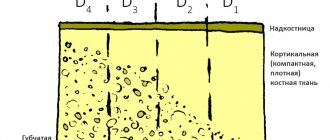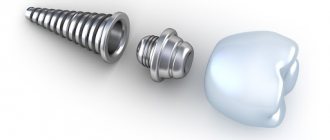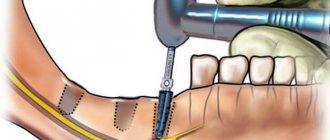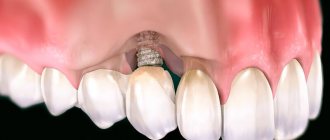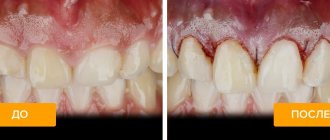The technology of installing artificial roots and then attaching dental crowns to them is becoming more and more popular every year. This is explained by several reasons. Firstly, every year there are more and more clinics in which dentists have mastered this technology. The second reason is the successful development of the technology itself, which has led to fewer and fewer cases of implant failure. Finally, the materials themselves are becoming higher quality, and therefore more durable.
PIK-Optima - a new word in dental implantation
The innovative biopolymer material PIK-Optima is a worthy replacement for titanium implants. The discovery of the excellent properties of the material belongs to a group of French scientists. In 2005, implants made from it appeared on the global dental market.
Advantages of the technology:
- long service life of structures;
- compliance with the patient’s jaw anatomy;
- do not cause allergic reactions;
- resistant to chemical influences.
PIK-Optima is used both to maintain soft tissues and to strengthen and replace hard bone structures. The material is flexible, easily adjusted to the desired size, and does not provoke destruction of surrounding tissues.
Vertical and inclined installation
Most structures are installed this way. If several pins are installed simultaneously, the doctor must observe the principle of parallelism. In some cases, the material is screwed into the bone tissue at an angle of 45 degrees. This is indicated when the base thickness is insufficient or its density is low due to atrophy and inflammation.
Inclined placement allows for large areas of solids to be brought into contact with the implant surface. In addition, this way you can bypass atrophied areas, anatomical structures, and prevent possible plastic surgeries. However, not all models are suitable for carrying out such manipulations.
Zirconium dioxide implants
Artificial roots made of zirconium have replaced metal ones and have a high level of biocompatibility with jaw tissue. The material is resistant to mechanical stress, matches the aesthetics of the natural root, and integrates well into the jaw tissue. Has the following properties:
- strength;
- durability;
- hypoallergenic.
Unlike titanium alloy, zirconium does not release metal particles into nearby tissues.
Basal implantation - a revolutionary technique
A relatively new technique for solving the problem of complete or partial absence of teeth is basal implantation. It allows the implant to be implanted into solid bone structures of the jaw with immediate loading of the prosthesis. This is a real revolutionary breakthrough in dental practice, as it eliminates the long wait for osseointegration of the artificial root with tissues. The process goes in parallel with the use of the inserted teeth.
At the stages of development of basal implantation, lateral implants with a disk base were used, which did not prove themselves due to the high trauma of installation and frequent rejections, and therefore are not used in modern implantology. Currently, screw implants are installed that can withstand immediate loads - they are characterized by aggressive threads with wide petals at the base, which ensures reliable fixation. They are fully adapted for dentures, fastening in the basal and cortical layers of the jaw.
Indications for the use of this method of restoring dentition are:
- partial or complete absence of teeth;
- thinning of the jawbone due to edentia;
- patient refusal to undergo jaw bone augmentation procedure;
- the need for a single restoration, urgent filling of the gap in the dentition.
Basal technology is contraindicated if:
- the patient suffers from uncompensated diabetes mellitus;
- is a carrier of HIV infection;
- suffers from tuberculosis;
- has serious immune disorders;
- there are diseases of the nervous and cardiovascular systems;
- malignant tumors;
- the tone of the masticatory muscles was noted.
The technology is characterized by a low-traumatic procedure and quick rehabilitation. You can fully use your new teeth within 3-7 days after surgery. In 90% of cases using the technique, bone augmentation is not required. Dentures are placed immediately after implantation. The price of the procedure is cheaper than the classic two-stage one.
In the Russian Federation, basal and compression Swiss models Oneway Biomed from the manufacturer Ihde Dental AG and ROOTT from Trate AG are more often used. Less common are the German short models Triton Titanium and the Israeli long zygomatic Noris Medical.
Indications:
- absence of most teeth or complete edentia;
- inability to wear a removable lamellar denture.
This modern implantation method allows people with removable dentures to securely fix it.
Complex implantation
. “All inclusive” in dental treatment. In one visit to the dentist, teeth are removed (if necessary) and an implant is inserted. A method for immediately restoring multiple teeth. Prosthetics on 6-12 implants with a fixed prosthesis.
ROOTT implant system
The Rutt system is represented by a wide range of implants, the model range includes more than 100 artificial roots; no other manufacturer has such a variety. This makes it possible to implement on one system all possible technologies known today - single and partial restorations, All on 4, All on 6, full basal complex protocols. There are various options for fixing prostheses - cement, multi-unit, on spherical attachments.
The basal implants of the system are a one-piece design with an adaptable abutment. Their smooth surface prevents the accumulation of microbes and promotes rapid osseointegration. The wide thread allows nutrients to flow freely into the tissue surrounding the implant. Installation can be performed in the socket of a newly extracted tooth.
Advantages:
- high percentage of engraftment;
- easy installation;
- not contraindicated for patients with HIV, AIDS, hepatitis, diabetes;
- can be installed for smokers;
- installation is allowed for periodontal diseases.
Indications:
- impossibility of two-stage implantation;
- absence of 3 teeth to complete absence;
- urgency of recovery.
Resmile
. Implantation technology without cuts or sutures. The transgingival method of implanting a titanium root is atraumatic, healing occurs quickly. The combination of implants from one system increases the success rate and minimizes complications. This is facilitated by a titanium-based ceramic composite prosthesis, which is installed on the 4th day and does not require replacement subsequently; it is permanent.
Designs with tapered abutment connection
Another improvement in the field of implantology is the development of a monolithic (non-removable) implant with a conical abutment. The cone ligament rationally distributes the load and provides the best mechanical stability of the artificial root. Thus, it became possible to insert the structure below the level of the cortical bone, which has poor blood circulation.
Advantages of the technology:
- integrity of the structure;
- uniform load distribution;
- impossibility of penetration of pathogenic microorganisms;
- fusion of tissues with implant coating;
- maintaining normal blood circulation of structures;
- excellent aesthetic appearance;
- long service life.
Features of working with the upper and lower jaw
The upper and lower jaws have distinctive tissue structure features. When fully implanting teeth, these features must be taken into account.
Full dental implantation of the lower jaw
The bone of the lower jaw is dense and massive, it is slowly resorptionable, so with complete implantation, 3 to 4 implants are sufficient to install the prosthesis. Osseointegration (implantation of an artificial root) in the lower jaw ends quite quickly: after 2–3 months (the period also depends on the individual characteristics of the patient’s body), the temporary prosthesis can be replaced with a permanent one.
Full dental implantation of the upper jaw
Here the bone is thinner. It is easily resorptionable, so it is very often impossible to carry out dental implantation without additional bone tissue augmentation. With a mild degree of resorption, dental implantation is carried out, but not 3-4 implants are installed, as in the lower jaw, but more, up to 8. If this type of implantation is not possible, zygomatic implantation is performed - special elongated implants are inserted into the zygomatic bone. Sometimes zygomatic implantation is combined with dental implantation - in addition, several conventional implants are installed in the alveolar process of the jaw.
The latest achievements of Israeli doctors
Israeli specialists perform the implantation of an artificial root carefully and consistently; the operation can take from 4 to 8 hours. Anesthesia is administered using Sleeper One technology, which involves a slow injection of anesthetic. This makes the procedure comfortable for the patient. The effect of the medicine begins after 40 minutes and leads to an absolute blocking of the sensitivity of the jaw. The method is safe and requires a minimum of time and money.
The rehabilitation period after implantation in Israeli clinics takes three days in the hospital. The patient must remain in a state of complete rest and follow the specialist’s recommendations. The medication course is selected individually. It usually includes anti-inflammatory and antibacterial drugs.
Where to go for the latest generation of dental implants
Only dental clinics with technologically advanced diagnostic and surgical equipment and highly qualified staff can offer a choice of modern methods of dental implantation and a guarantee for their work.
The table shows several Moscow clinics where you can restore a beautiful smile in an advanced way. We advise you to find out the cost and current promotions directly on their websites.
| dental clinic | Website |
| Center for Dental Implantology ROOTT (RUTT) | https://dentalroott.ru |
| Dentum dentistry | https://dentumclinic.ru |
| City-Dent | https://city-dent.rf |
| The president | https://www.prezi-dent.ru |
| Center Family Dentistry | https://family-dental.ru |
Japanese scientists create implants similar to natural teeth
Creating an artificial organ biologically identical to a natural one is a difficult task. Japanese scientists under the leadership of Professor Takashi Tsuji coped with it “excellently.” They created a biohybrid dental implant that completely recreates the structure and function of a natural tooth. The development is based on coating a conventional titanium implant with hydroxyapatite and stem cells from dental follicles.
Studies have shown that after installation of the implant, active regeneration of periodontal tissue occurs and it begins to function like a natural tooth. Capable of feeling pain and responding to mechanical stress.
The work of scientists is still ongoing; now the material is not yet used for dental purposes . The biohybrid implant is a great achievement, which in the near future will be used to restore lost teeth.
Alternative Methods
You can restore the integrity of the dentition using:
- removable prosthetics. It is inexpensive and can immediately replace all lost teeth. But it takes a long time to get used to such voluminous structures; at first they can cause a gag reflex. For more reliable fixation, additional means such as Corega are often used to prevent the prosthesis from accidentally falling out. Aesthetics are poor, and tissue atrophy progresses inexorably. With prosthetics on implants this is impossible.
- prosthetics with a bridge supported by adjacent teeth. In this case, the supporting teeth grind down and become weaker. With constant chewing load, such structures may collapse over time.
- crowns If the tooth root is preserved, it can be restored with a crown. If the root is destroyed, then the only options left are single implantation or a bridge;
- classical implantation. A two-stage protocol involves installing a root-shaped implant, waiting for it to engraft into the bone, and only then fixing the permanent prosthesis. This is a long process (from 3 to 6 months), during which the titanium rod is completely osseointegrated into the jaw bone.
New developments by Malaysian scientists
Scientists from the Department of Restorative Dentistry at a Malaysian university have developed a new type of implant designed for older age groups of patients. Their work was based on the creation of a special bioceramic coating made of magnesium silicate for the rod and abutment, which will ensure rapid fusion with bone tissue.
The researchers also developed a new method for making titanium structures. It involves microwave sintering of the implant after coating it with titanium powder. This favors rapid implantation, improvement of the aesthetic effect, as well as the quality of implantation.
The leader of a group of Malaysian scientists, Alirez Yagubi, believes that the creation of personalized dental systems is a promising area of biotechnology. Each patient is unique and requires an individual approach.
Development continues, clinical trials of new implants are being conducted. In the future - increasing the service life of structures, creating high-quality products accessible to all categories of the population.
Indications:
- absence of one, several teeth or complete edentia.
Dental implantation using a surgical template
. The use of 3D modeling helps the doctor accurately plan the operation, eliminating all risks and undesirable consequences. The modern method of implantation using a surgical template is the key to the successful work of an implantologist and orthopedist.
After a CT (computed tomography) scan, the doctor outlines the location of the implants in the program, which he then works with to decide at what angle and what type of implant to install. And the technician is already preparing to make temporary crowns and prostheses, which will be fixed on the day of implantation.
What trends are expected in this area?
Unlike dentures, implants do not need to be periodically replaced with new ones . They help make your smile beautiful, natural and healthy at any age. However, their main advantage is the complete restoration of dental functions.
Nowadays there are dental structures made of different materials: titanium alloy, ceramics, biopolymer. Technology improvements continue. Thus, Spanish scientists have created completely new dental implants with a biodegradable coating. They integrate much faster into living tissues; upon contact, the coating particles gradually dissolve. This helps accelerate bone regeneration.
Price
Modern dental implantation is more expensive than prosthetics. The cost of treatment depends on several factors:
- chosen method;
- use of a surgical template;
- number of implants;
- company manufacturer;
- material of prosthesis, crown;
- qualification of an implantologist.
For example, the price of one-stage implantation with a temporary crown is about 40,000 rubles, the All-on-4 technology of one jaw with an adaptive prosthesis will cost from 190,000 rubles, one-stage implantation with complete edentia of one jaw on 6 compression implants and a temporary prosthesis - in the region RUB 265,000 The cost item may increase due to additional diagnostics and prosthetic materials.
